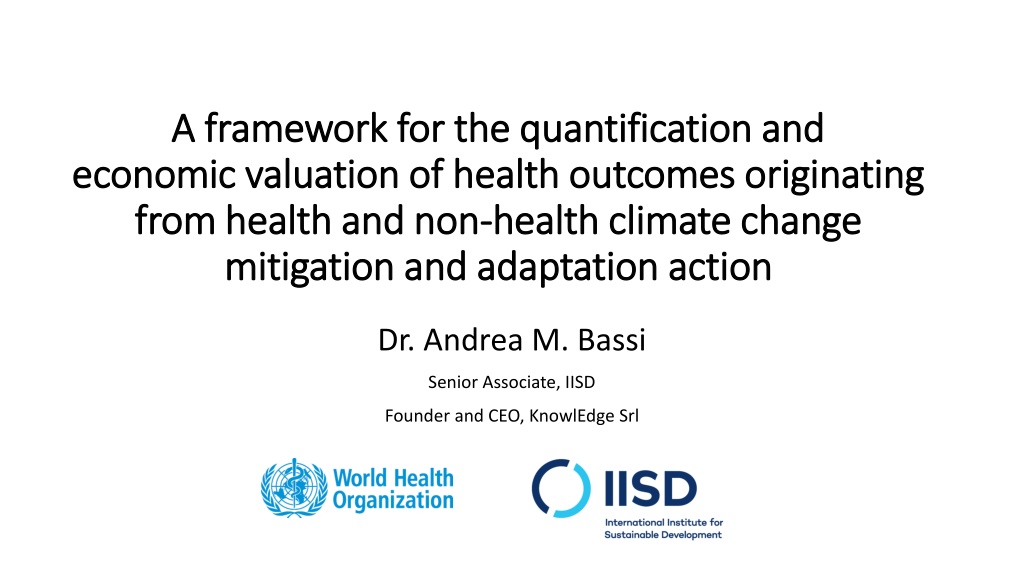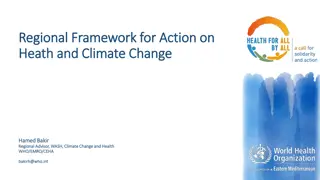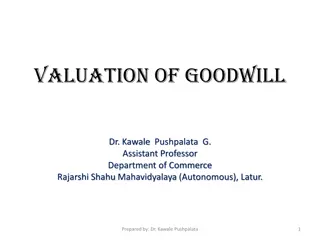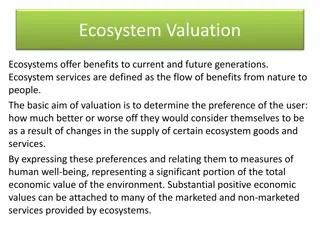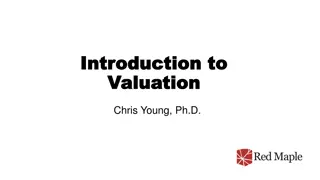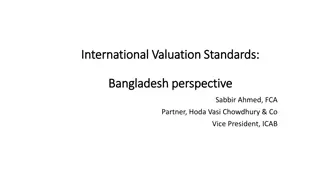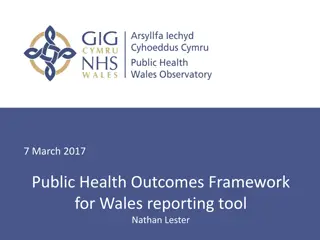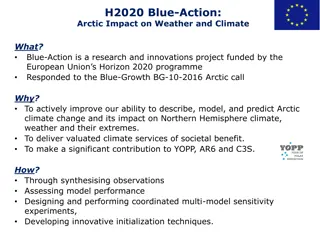Framework for Economic Valuation of Health Outcomes in Climate Action
Economic assessments of climate action often overlook health co-benefits, which can significantly impact the viability and desirability of mitigation and adaptation strategies. A framework is essential to model the effects on health, enabling a comprehensive assessment that integrates knowledge across sectors and highlights the central role of health in development. Integrating knowledge leads to better policy decisions by minimizing risks and maximizing synergies.
Download Presentation

Please find below an Image/Link to download the presentation.
The content on the website is provided AS IS for your information and personal use only. It may not be sold, licensed, or shared on other websites without obtaining consent from the author. Download presentation by click this link. If you encounter any issues during the download, it is possible that the publisher has removed the file from their server.
E N D
Presentation Transcript
A A framework framework for the quantification and for the quantification and economic valuation of health outcomes originating economic valuation of health outcomes originating from health and non from health and non- -health climate change health climate change mitigation and adaptation action mitigation and adaptation action Dr. Andrea M. Bassi Senior Associate, IISD Founder and CEO, KnowlEdge Srl
Introduction Introduction Economic assessments of climate action often fail to include associated health co- benefits. On the other hand, as an example, mitigation policies and technologies can modify health-related risks and exposures like air pollutants, diet, and physical activity. Excluding avoided costs emerging from health co-benefits can result in an unbalanced assessment of the economic viability and desirability of climate mitigation and adaptation actions.
Why a framework to model Why a framework to model climate/policy effects on health? climate/policy effects on health?
Why a framework to model Why a framework to model climate/policy effects on health? climate/policy effects on health? First, it sets the stage for the creation of a systemic assessment that better reflects the complexity of the real world. Second, it allows for knowledge integration, between health economics and policy assessment across sectors. Third, it links policymaking across sectors, highlighting how health is at the center of development. Fourth, it can result in valuable health gains, including reductions in health care financial costs, as a co-benefit, when implementing climate mitigation and adaptation investments.
Setting the stage for knowledge integration Setting the stage for knowledge integration This document argues the value of integrating knowledge across fields of research and thematic policy areas. This is important to ensure that policy decisions are made by taking into account information pertaining direct, indirect and induced outcomes of policy implementation. If the policy analysis performed is systemic, there is a lower risk that side effects will emerge and there is a higher probability that synergies will be realized. If side effects are identified before policy implementation, there will be an opportunity to prepare and formulate a policy package that may prevent the emergence of such side effects.
Setting the stage for knowledge integration Setting the stage for knowledge integration
Elaborating a conceptual framework Elaborating a conceptual framework
Implementation steps Implementation steps 1. Explore development impacts on health 2. Assess climate change impacts on health 3. Identify intervention options climate change mitigation and adaptation 4. Select relevant indicators for economic analysis 5. Identify and use of suitable methods and models
How to prioritize interventions How to prioritize interventions Cost-Benefit Analysis (CBA) Provides a comparison of cost and the economic value of the outcome Cost-Effectiveness Analysis (CEA) Provides a comparison of cost and outcome Multi-criteria analysis (MCA) Includes multiple quantifiable and non-quantifiable criteria, can be seen as a bridge between CBA and CEA How do CBA and CEA compare? CEA may suggest to invest that are not necessarily economically viable, but are more effective than others. CBA may suggest to invest in areas that are most economically viable, but not necessarily relevant in relation to the challenge at hand.
Pilot Pilot- -testing the framework testing the framework 1. Climate smart agriculture Adaptation / nutrition 2. Planting trees Mitigation and adaptation / flood mitigation 3. Planting trees in cities Mitigation and adaptation / heat mitigation, diarrhea 4. Improved building design Mitigation and adaptation / vector borne diseases 5. Energy efficiency, renewable energy and fuel switching Mitigation / human health 6. Climate proofing of health facilities Mitigation and adaptation/ facility operations and mortality
Adaptation Action 1: Climate smart agriculture Adaptation Action 1: Climate smart agriculture Step 1 - Development impact on health: the use of unsustainable production practices has led to an increase in soil erosion and reduced land productivity. Step 2 - Climate change impact on health: climate variability has resulted in an increased risk of droughts and floods, both impacting negatively on land productivity. Step 3 - Climate action considered: climate smart agriculture practices, aimed at increasing land productivity by increasing resilience to climate change and supporting the implementation of sustainable practices, such as the use of integrated pest management rather than herbicides. Step 4 - Indicators quantified: investment required, impact on land productivity and production, avoided cost of climate induced impacts on nutrition. Step 5 - Models utilized: data on land use productivity under normal conditions, climate change and climate smart practices.
Action 2: Planting trees (flood mitigation) Action 2: Planting trees (flood mitigation) Step 1 - Development impact on health: land clearing for the expansion of residential areas and agriculture have resulted in more frequent -and amplified impacts of- flood events. Step 2 - Climate change impact on health: climate variability has led in increased risk and severity of floods, with stronger and more frequent extreme precipitation events, impacting a larger number of people over time. Step 3 - Climate action considered: planting trees around urban areas, where they provide protection against floods (adaptation goal) and increase carbon sequestration (mitigation goal). Step 4 - Indicators quantified: investment required, avoided costs from flooding, avoided mortality and impacts on human health (malnutrition, waterborne diseases, loss of property). Step 5 - Models utilized: spatial models (InVEST) to assess runoff reduction based on land cover changes.
Action 2: Planting trees (flood mitigation) Action 2: Planting trees (flood mitigation) Difference between LULC Trees and LULC BAU (%) Considering the investment for tree planting in Islamabad ($6,566,786), and the estimated number of people that will avoid the negative consequences of flooding (12,300), we can estimate that the cost of avoiding the impact of flooding would amount to approximately 534 $/person. Total Runoff Retention Volume (m3) LULC Scenario LULC BAU LULC Trees 64,252,934.72 72,158,136.63 12.30 $ over a 30-year period $39,110,310 $18,450,000 $57,560,310 $6,566,786 $50,993,524 Avoided costs from flooding Avoided costs from extreme events Total avoided cost Investment for tree planting in Islamabad Net savings
Action 3: Planting trees (urban cooling) Action 3: Planting trees (urban cooling) We estimate a 0.7 C reduction in temperature in warm days due to tree planting. The avoided cost of diarrhea is approximately 10% of the capital and O&M cost of tree planting. Urban tree planting efforts in Islamabad may avoid an increase of 3.22% of diarrhea cases, or 102.35 cases annually (adding up to 3,070.43 cases over 30 years). Considering the capital investment for tree planting in Islamabad ($6,531,643), we can conclude that $2,127.27 are needed to avoid a single case of diarrhea in the capital city. Nevertheless, the benefits are be higher in more densely populated areas, and include also air pollution reduction, water filtration, improvement of mental health, and improvement of labor productivity.
Action 6: Climate proofing of health facilities Action 6: Climate proofing of health facilities Step 1 - Development impact on health: infrastructure is vulnerable to climate change impacts, it was not designed to withstand climate extremes. Step 2 - Climate change impact on health: increased frequency and severity of extreme climate events, increasing vulnerability of health facilities and interruptions of health service delivery. Step 3 - Climate action considered: retrofitting non-structural items, passive and active design measures, electricity system hardening (undergrounding), solar PV (both representing climate adaptation and mitigation goals). Step 4 - Indicators quantified: investment required, avoided costs of energy and water consumption, avoided costs of power outages, avoided mortality. Step 5 - Models utilized: data and results of studies found in the literature related to the frequency of power outages, hospital energy use, and impact of climate change on operations.
Action 6: climate proofing of health facilities Action 6: climate proofing of health facilities Total Payback Period (years) Avoided Costs NPV IRR BCR investment * Full CBA 1 (retrofitting, design, undergrounding) *Full CBA 2 (retrofitting, design, solar PV) $59,563,132 $233,256,921 $100,717,735 49% 3.26 3 $16,430,484 $243,981,669 $137,668,103 110% 10.61 1 *Electricity system hardening $58,424,843 $227,520,000 $97,996,048 48% 3.24 3 *Solar PV and battery storage $15,185,917 $227,520,000 $136,952,283 113% 11.22 1 Full CBA 2 (retrofitting, design, solar PV) $16,430,484 $16,461,669 $(4,066,988) 0% 0.72 20 Retrofitting non-structural items $414,200 $3,113,636 $1,603,546 70% 5.77 2 Passive design measures $344,659 $2,623,285 $1,354,509 71% 5.84 2 Solar PV and battery storage $15,185,917 $13,838,384 $(4,782,808) -1% 0.64 N/A Avoided cost of mortality $4,781,750 / year * considers the avoided costs of power outages
Lessons learned Lessons learned Knowledge integration is not an easy task. If not performed correctly it may result in misleading policy recommendations and a higher risk of failure for policy implementation. It is critical that data are validated, assumptions are cross-checked for consistency, and results are analyzed in relation to their plausibility from a sectoral and systemic point of view. Computational reproducibility, or the possibility for other researchers to reproduce the analysis performed, is also essential to ensure transparency and buy-in for the results produced.
Recommendations Recommendations On conceptualization of the exercise: consider whether the analysis of health co- benefits is required to: (i) complement an already available and detailed assessment, requiring solid information and high confidence in the results generated, or (ii) to shed light on new outcomes that have never been assessed, and for which a certain degree of uncertainty is acceptable. On data collection, first search for historical data then test such data against existing models or published values. Consult experts and consider the use of simulation models to fill data gaps. On model development and its validation, always perform direct structure tests to assess the validity of the model structure by direct comparison with knowledge about the structure of the real system.
Recommendations Recommendations On the economic valuation of health co-benefits It is critical to have information and data on the driver of change (e.g. kg or tons of air pollutants emitted) and on the economic value of such driver (e.g. health cost of air pollution per ton of pollutant emitted). On data inputs It is important to rely on local (or country-specific data). The use of information from other countries, sectors or sources not directly connected to the study area is likely to lead to imprecise results. On uncertainty Perform sensitivity analysis if input parameters have been used for which data/observations were lacking. Determine whether the results are solid enough, in case there is little evidence to support the outcomes of the analysis.
Thank you Thank you For more information you can find us at: Andrea Bassi: andrea.bassi@iisd.net Lourdes Sanchez: lsanchez@iisd.org Marina Maiero: maierom@who.int Diarmid Campbell-lendrum: campbelllendrumd@who.int
